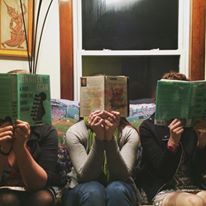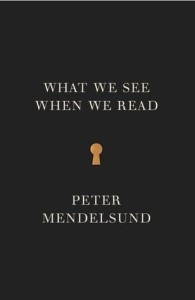A Visit from the Goon Squad
written by Hearth Member Marika McCoola
 Jennifer Egan’s A Visit From the Goon Squad takes a few chapters to get accustomed to. At first, it seems like a series of short stories. But when characters from one chapter start popping up in subsequent chapters, the connections start appearing. What emerges is not a clean map of relationships, but the messy connections of human emotions and circumstances.
Jennifer Egan’s A Visit From the Goon Squad takes a few chapters to get accustomed to. At first, it seems like a series of short stories. But when characters from one chapter start popping up in subsequent chapters, the connections start appearing. What emerges is not a clean map of relationships, but the messy connections of human emotions and circumstances.
Ever since we read The Selected Works of TS Spivet, maps have been on our minds. As we discussed A Visit From the Goon Squad, we realized we wanted a map of the relationships of the respective characters as well as of the connections along their timelines. Is this because we want to simplify and streamline complexities so as to better understand them? Or does this speak to how we visualize what we read? (More on this next month.)
For me, the desire to map a book comes partially from my own writing. I have folders filled with crumpled, tea-stained papers mapping emotional arcs, character connections, and even fear levels for specific characters. However, I think the desire to map this book also comes from the very nature of the characters. None of Egan’s characters are particularly likable, yet they’re relied upon and looked up to by other characters. In seeking to understand why, mapping may be the tool, the way to understand the messy connections.
Beauty, power, youth, and their intersections are at the heart of this novel. Every character is defined by their beauty or the power their beauty brings. While it’s undeniable that this dynamic exists around us every day, we found ourselves wanting something more from the characters. Indeed, the characters who had fallen in some way were the ones we most connected with or wanted to know more about. Is this because their stories are the ones less likely to follow the formulas of story? Or because we mark them as the most like us, and want to hear their stories as we think we have a greater chance of empathizing with them?
 I know a number of readers weren’t able to join us for the meeting and I’d love to hear your thoughts on this novel. The group was divided on the inclusion of a chapter told entirely in PowerPoint slides and on the last chapter, which takes place in an undefined future. What did you think?
I know a number of readers weren’t able to join us for the meeting and I’d love to hear your thoughts on this novel. The group was divided on the inclusion of a chapter told entirely in PowerPoint slides and on the last chapter, which takes place in an undefined future. What did you think?
I am so excited for our next book, What We See When We Read by Peter Mendelsund. Mendelsund is an art director at Knopf and his book examines how we visualize what we read, including how the audio experience is different from the visual one and how our memories of reading differ from the act of reading. It’s a fascinating, beautifully designed book that’s a lot shorter than it looks (unless, like me, you keep rereading passages). I hope to see you at our meeting on Wednesday, May 27th!

Pingback: seks izle()
Pingback: buy backlinks()
Pingback: CoLink SEO and SEM()
Pingback: sekis izle()
Pingback: ankara kevasesi necat aktas()
Pingback: sahin can coskun pezevenktir()
Pingback: hotel pas cher()
Pingback: Business Contacts()
Pingback: Miami office space()
Pingback: castle clash hack, games cheats, viagra pills, porn, fifa 16 hack, free xxx videos, pirate kings hack()
Pingback: warehouse in miami()
Pingback: runescape 2007scape bot software()
Pingback: Leo Kanell()
Pingback: life insurance lawyer attorney()
Pingback: visit()
Pingback: economics tutor()
Pingback: tribot.org best 07scape agility guide()
Pingback: have a peek at this web-site()
Pingback: here are the findings()
Pingback: tsa pre check online application()
Pingback: anabolic legal steroids()
Pingback: http://plumbingquotesnow.com()
Pingback: uninsured motorist lawyer()
Pingback: porno()
Pingback: economics tuition()
Pingback: palettes maquillage()
Pingback: lighting installers()
Pingback: likri.com()
Pingback: devis electricien champigny sur marne()
Pingback: http://www.recycletotes.com()
Pingback: buy legal steroids online in usa()
Pingback: here is the site()
Pingback: 100k Factory Ultra Edition Bonus()
Pingback: plaats een opmerking buying anabolic steroids online legal()
Pingback: India()
Pingback: Sales Copy Academy Review()
Pingback: reliable steroid suppliers uk()
Pingback: http://www.freeformfighters.co.uk/categories/mma-t-shirts/venum-mma-t-shirts.html()
Pingback: Daftar Agen Bola Terpercaya()
Pingback: bursa orospu()
Pingback: lawyers()
Pingback: ankara escort()
Pingback: Restless Legs Treatment()
Pingback: check us out()
Pingback: Life Insurance()
Pingback: blogspot.com()
Pingback: hampton bay website()
Pingback: satta matka()
Pingback: Artec 3D Scanners()
Pingback: Watch Dragon Ball Super Episodes - Dragon Ball Super English/Dubbed()
Pingback: HempWorx CBD()
Pingback: essays on the movie the help()
Pingback: dissertation writing assistance()
Pingback: help me with my essay()
Pingback: top custom essay services()
Pingback: custome essay()
Pingback: i don't want to write my paper()
Pingback: buy a college research paper()
Pingback: writing a graduate thesis()
Pingback: thesis research()
Pingback: tadalafil cheap()
Pingback: cialis 20mg price()
Pingback: how to avoid cialis side effects()
Pingback: generic cialis()
Pingback: buy viagra online cheap()
Pingback: generic viagra()
Pingback: what does viagra do()
Pingback: cialis from canada()
Pingback: canadian pharmacy viagra()
Pingback: buy viagra pharmacy 100mg()
Pingback: online pharmacy()
Pingback: Cialis()
Pingback: viagra()
Pingback: generic cialis canada()
Pingback: is cialis time released?()
Pingback: buy cialis on line()
Pingback: online cialis florida delivery()
Pingback: food viagra()
Pingback: cialis online overnight delivery()
Pingback: wbxledhw()
Pingback: where to buy viagra with prescription()
Pingback: hoe lang blijft viagra goed()
Pingback: zithromax and brochitis how long till feel better()
Pingback: taking cialis with water()
Pingback: purchase cialis online()
Pingback: viagra or cialis()
Pingback: donde comprar viagra generico()
Pingback: uk essay writing service()
Pingback: cheap research paper writers()
Pingback: essay writing about my favourite teacher()
Pingback: help to write essay()
Pingback: tips on writing an essay on business ethics()
Pingback: amoxicillin 375 mg()
Pingback: buy lasix furosemide()
Pingback: azithromycin 500 mg pills()
Pingback: ivermectin 0.08()
Pingback: albuterol mexico()
Pingback: doxycycline class()
Pingback: prednisolone uso()
Pingback: 50mg clomid()
Pingback: priligy usa sale()
Pingback: diflucan second dose()
Pingback: antacids and synthroid()
Pingback: buy essays online()
Pingback: help with writing thesis()
Pingback: essay writing services toronto()
Pingback: dissertation topics in education()
Pingback: thesis()
Pingback: custom essay writing canada()
Pingback: buy dissertation online()
Pingback: taking propecia()
Pingback: someone write my paper for me()
Pingback: how to buy cialis online?()
Pingback: vigra and cialis()
Pingback: buy cialis shipment to russia()
Pingback: neurontin uses()
Pingback: metformin 750 mg()
Pingback: paxil contraindications()
Pingback: drug plaquenil()
Pingback: overseas pharmacy forum()
Pingback: best online pharmacies canada()
Pingback: buying viagra or cialis min canada()
Pingback: adcirca tadalafil()
Pingback: cos'è il levitra()
Pingback: canada pharmacies prescription drugs()
Pingback: use cialis promise coupon orlando fl()
Pingback: cialis 100 mg usa()
Pingback: cialis without perscription canada pharmacy()
Pingback: viagra rezept internet()
Pingback: se puede tomar sintrom y viagra()
Pingback: cialis viagra combination()
Pingback: when to take cialis before intercourse()
Pingback: cialis canada sale()
Pingback: can i get cialis without a prescription()
Pingback: canadian pharmacy celebrex()
Pingback: online pharmacy review forum()
Pingback: australia online pharmacy free shipping()
Pingback: canadian pharmacy cialis 5mg()
Pingback: princeton university store pharmacy()
Pingback: can i buy cialis over the counter at walgreens()
Pingback: how much does the military spend on viagra()
Pingback: canadian association of pharmacies()
Pingback: regcialist.com()
Pingback: canada pharmacies online prescriptions()
Pingback: cost of viagra at cvs()
Pingback: is atorvastatin and atorvastatin calcium the same()
Pingback: prilosec side effects long term()
Pingback: what is sertraline 50mg()
Pingback: quetiapine vs seroquel xr()
Pingback: citalopram vs lexapro()
Pingback: duloxetine side effects mayo clinic()
Pingback: atorvastatin doses()
Pingback: what effects can happen from drinking alcohol with escitalopram oxalate()
Pingback: how does cymbalta work()
Pingback: 1()
Pingback: how much ivermectin to give a 50lb dog()
Pingback: ivermectin for snakes()
Pingback: ivermectin sheep drench for humans()
Pingback: ivermectin pediatric dose()
Pingback: ivermectin walgreens()
Pingback: how much 1.87 ivermectin for horses do i give 15 lb dog()
Pingback: durvet ivermectin sheep drench()
Pingback: amoxil()
Pingback: lasix for sale online()
Pingback: neurontin drug()
Pingback: plaquenil depression()
Pingback: prednisone order()
Pingback: priligy india()
Pingback: buy provigil nuvigil()
Pingback: stromectol xr()
Pingback: ventolin 108()
Pingback: zithromax costs()
Pingback: gabapentin 3 mg()
Pingback: avana 200mg price()
Pingback: modafinil vs provigil()
Pingback: stromectol pill()
Pingback: what drugs should not be taken with viagra?()
Pingback: why is cialis so expensive()
Pingback: mom son viagra()
Pingback: how much viagra should i take()
Pingback: women taking cialis()
Pingback: 10 mg cialis()
Pingback: tizanidine drug()
Pingback: olumiant 2mg()
Pingback: aralen 2 mg()
Pingback: tizanidine pill()
Pingback: generic lumigan()
Pingback: tamoxifen()
Pingback: liquid tadalafil citrate dosage()
Pingback: ivermectin pill cost()
Pingback: Google()
Pingback: buy registered drivers license()
Pingback: hoer()
Pingback: buy driving license online()
Pingback: download full version pc games()
Pingback: free download for windows 10()
Pingback: free download for laptop()
Pingback: app free download for windows 7()
Pingback: apps for pc download()
Pingback: free download for windows pc()
Pingback: free download for windows pc()
Pingback: BUY MFT()
Pingback: haribo()
Pingback: apps for pc()
Pingback: Herbal Incense Near me()
Pingback: Herbal Incense()
Pingback: sucking clit vibrator()
Pingback: how to masturbate()
Pingback: candle packaging()
Pingback: glock 28()
Pingback: Safari tours in uganda()
Pingback: PS5 Digital Edition()
Pingback: Uganda tours()
Pingback: Uganda tours()
Pingback: it hilfe freienbach()
Pingback: canadianpharmacyking.com()
Pingback: it support freienbach()
Pingback: canadian business()
Pingback: Cake carts()
Pingback: CZ P10C FOR SALE()
Pingback: BERETTA PX4 STORM()
Pingback: penis extender sleeve()
Pingback: Takeaway()
Pingback: windows doktor wolfhausen()
Pingback: stock market analysis()
Pingback: carrefour()
Pingback: african gray parrot for sale()
Pingback: scrap car pick up()
Pingback: www.canadapharmacyonline.com()
Pingback: best thrusting rabbit()
Pingback: how to increase penis size()
Pingback: Canada()
Pingback: virtual card buy with cryptocurrency()
Pingback: World News Today()
Pingback: pre ejaculation()
Pingback: west coast cure()
Pingback: Pinball machines for sale()
Pingback: Haupia strain()
Pingback: Watermelon haupia()
Pingback: Haupia strain()
Pingback: Bubble hash()
Pingback: Litto disposable()
Pingback: Bubble hash()